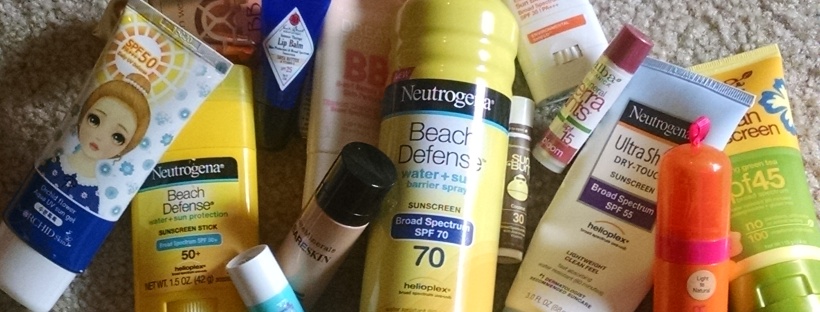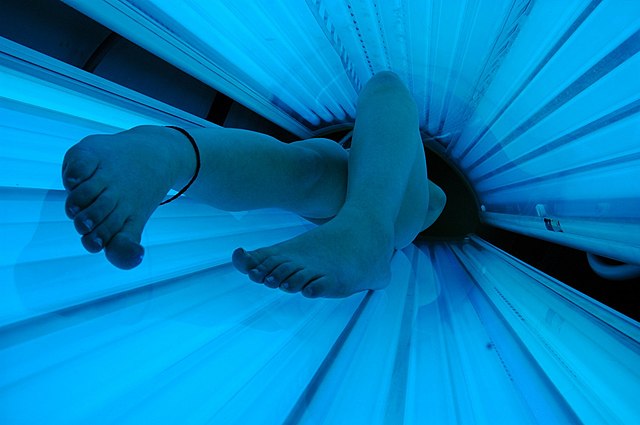I’m back guys! Sorry for the long absence!
Let’s talk sun protection. Granted, it’s technically fall now, and you’re probably breaking out lots of clothes with sleeves and layers and scarfy bits, but the sun’s not actually going anywhere. If you’re at a high altitude, in a tropical/equatorial zone, or maybe somewhere in the southern hemisphere, the UVB rays aren’t even going to diminish in their vicious intensity. As a melanin-deprived individual, for me the threat is constant, no matter where I am. I’m pretty sure my people must’ve adapted for arctic cave dwelling. Or maybe we’re meant to be nocturnal?

Oh hello, Hilo!
Rebuking all of that, I went to Hawaii last month. I have the best patchy leg tan now, you guys! Related advice: if you’re going to kayak, then snorkel, then get back in the kayak to go back from whence you came, maybe reapply sunscreen somewhere in between those steps. Don’t just lay back in the kayak and lounge with your arms grazing the surface of the water for an indefinite amount of time. At least, not if you need to make use of your knees at all the next day. Ouch. So much ouch.
But Nichol, you might be asking (because in my head this is often a dialogue) what about reef-safe sunscreen? What about CHEMICALS? What does SPF even mean? If I don’t ever burn, why do I need to care?
Gah! Question barrage! Take a seat, I guess. This might take a while. Tl:dr: anyone who tells you not to wear sunscreen in order to avoid the potential cancer-causing ingredients is dumb, because you know where your biggest skin cancer risk comes from? The sun. When in doubt, put on a hat and throw on some form of sunscreen, even if it costs $2.99/a gallon and smells a little like paint. In the long run, you will be better off. Unless you confused sunscreen and actual paint. What did I tell you before about always reading labels???
What does SPF stand for and what does it mean for me?
SPF stands for sun protection factor. The rating system was developed in 1962, but is only meant to measure a sunscreen’s effect on the absorption of UVB rays. Those are the rays that will burn you. UVA rays, on the other hand, are more insidious. They’re longer wavelength rays that penetrate deeper into your skin and are responsible for pre-mature aging and many forms of skin cancer. UVB rays are also carcinogenic, but they’re not going to age you as much, because your body can just kick out the damaged cells (Enjoying that peeling skin? You immune system says ‘you’re welcome’. It’s like your cat bringing dead mice to you. Or your gall bladder making stones. The intent was good, even if the result sucks.). Also, UVA rays can penetrate glass and hit us with a consistent intensity throughout daylight hours. UVB rays reach their peak between 10AM and 4PM, and are more intense in the summer months, at high altitudes, and around reflective surfaces (like water, ice, snow, or giant floor mirrors).
What SPF translates to in terms of hours of protection varies by person. To figure out what this means for you, there’s a nifty little equation:
Minutes to burn without sunscreen x SPF number = maximum sun exposure time
How long does it take for you to burn without sunscreen? You should apparently know that, even though that number obviously will vary based on where you are and what you plan on doing outside. Anyway, take an educated guess, plug it into the equation and BAM! There you have the maximum time you should reasonably expect to be protected. Or, put another way, whatever your baseline burn time is, an SPF 15 claim means you should be able to expect 15x that, an SPF 30 would be 30x, and so on.
But wait – your educated guess might not even help you, because people in the real world tend to use far less sunscreen than people testing it out in lab settings to determine the bottle-listed SPF value, which could mean you’re getting as little as half the protection time you’ve just calculated. Point being, you should underestimate the times and reapply often. Especially if you, like me, are pale enough to almost emit a faint glow and/or spend 95% of your time either in the water or hiking uphill until you weep and sweat sunscreen like it’s your only remaining bodily fluid. Man, I should really give in and take up spelunking. In the arctic.
You also shouldn’t count on an SPF of 50 or 70 giving you much longer and better protection than an SPF of 15 or 30. In addition to the confusing and flawed nature of the seemingly basic formula above, SPF also indicates UVB absorption, but not in a way that makes much sense on the face of it. SPF 15 will absorb roughly 93.3 percent of UVB rays, but if you go mad and shoot up to SPF 50, you’re still only moving up to 98 percent UVB absorption.
Bottom line here: shoot for SPF 30 or above and reapply at least every couple hours. SPF provides a decent jumping off point for understanding UVB protection, but there are a lot of issues with relying solely on that little number. Also, I feel like we’re leaving out something huge…
What about UVA?
Oh yeah! UVA! That guy! What’s he been up to? Where did all these wrinkles come from?
Most modern sunscreens contain added ingredients to block or absorb UVA rays, as well as UVB. Look for the terms UVA/UVB protection, broad spectrum, or multi-spectrum on the label. You could also check for avobenzone, oxybenzone, zinc oxide or titanium dioxide in the ingredient list. Those will help. Unfortunately, there’s still no consensus just how much those will help or how much of those ingredients we need to throw in to even ensure adequate protection.
If you’re still getting super tan, that might mean you need to try another combination of ingredients to up your UVA protection numbers. If you’re burning, that’s, once again, a UVB problem. You likely need to reapply your sunscreen more often and, if you’re using SPF 30 or below, consider switching to a higher SPF value. Also look for sweat- and water-proof sunscreens (but still reapply after sweaty or watery activities). It’s also best to initially apply sunscreen 15 to 30 minutes BEFORE sun exposure, to give it a chance to absorb (unless you’re going solely for UV blocking/physical sunscreens, which we will get around to, I promise). Some sunscreens claim to absorb quicker, but, especially if you intend to hop into a body of water after application, it’s still a good idea to observe the recommended wait time. Otherwise, you’re probably doing more to sun-protect the respiratory system of nearby fish than to protect yourself.
One More Acronym I Keep Seeing: UPF
UPF is like SPF for clothing. As with SPF, the number is based on your ratio of burn time without protection to burn time with protection (although, in measuring UPF, they’re using instruments to calculate UV penetration levels instead of just burning people).

Pictured: Non-optimal summer fashion
Tighter woven, UV absorbing (darker colored), and thicker fabrics provide a greater level of natural protection.The typical UPF rating for standard western summer clothing (think, a flimsy t-shirt) is around a 6. Protective fabrics, like rash guards or outdoor athletic wear, tend to hover around a UPF of 30. The highest possible UPF rating is 50+, which blocks 97.5 to 98 percent of UV radiation. I guess, theoretically, if you were wearing a lead coat around, you could probably reach a higher protective rating, but at that point you’re facing other issues, both from overheating and from all that lead hugging your sweaty body. Also, if that’s your solution, swimming is pretty much out. You know what? General rule of thumb: do not wear lead for your outdoor activities unless those activities involve nuclear testing (of the legal, government sanctioned variety).
—————————————————————————————————
And that’s it for part one. Hopefully this gives you a baseline understanding of UV rays and key sun protection terms. Up next, we’ll cover the wide variety of sunscreens available and try to figure out if any of them are doing more harm than good (to us and to the environment). There is an enormous amount of stuff to cover on this topic and a ridiculous amount of environmental- and health-based controversy. Hopefully I’m able to do it some justice. If you’re a dermatologist or some kind of sunscreen expert and would be willing to submit to ALL THE QUESTIONS, let me know, because I aim for accuracy and crave your wisdom. Also, thanks to How Stuff Works and to The Skin Cancer Foundation, both of whom I’ve relied on a lot for research. Both are excellent sources for more info.


